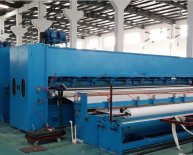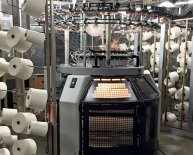
Woven fabric manufacturing process
Other than the traditional fabrics, in view of the increased demand of textile for technical and industrial use, many speciality fabrics have also gained importance. Among these are included Abrasive, Aluminized, Awning, Blended, Carbon, Fiberglass, Flame Resistant, Narrow, Tarpaulin, Vinyl Fabric to name a few.
Fabric Manufacturing Techniques
The traditional methods of manufacturing fabrics are weaving, knitting and braiding. The more unconventional method include bonding fibers by mechanical, thermal, chemical or solvent means.
Weaving
Weaving is described as inter-lacing, usually at right angles, of two sets of threads to form cloth, rug or other types of woven textiles. Today this process is mostly automated for mass production. In it, two distinct sets of yarns called the warp and the filling or weft are interlaced with each other to form a fabric. The lengthwise yarns which run from the back to the front of the loom are called the warp. The crosswise yarns are the filling or weft. A loom is a device for holding the warp threads in place while the filling threads are woven through them.
Knitting
After weaving, the most prevalent method of fabric construction is knitting. The yarn in knitted fabrics follows a meandering path, forming symmetric loops or stitches. When the interlocking loops run lengthwise, each row is called a wale. A wale can be compared with the warp in weaving. When the loops run across the fabric, each row is called a course. A course corresponds to the filling, or weft. There are two major varieties of knitting: weft knitting and warp knitting. In weft knitting, one continuous yarn forms courses across the fabric. In warp knitting, a series of yarns form wales in the lengthwise direction of the fabric.
Braiding
A braid is a rope like thing, which is made by interweaving three or more strands, strips, or lengths, in a diagonally overlapping pattern. Braiding is one of the major fabrication methods for composite reinforcement structures. It is done by intertwining of yarns in whatever direction suited to the manufacturer's purpose. From a domestic art of making laces, it evolved as a fabric made by narrow width looms. Of late, Crochet knitting machines have replaced large numbers of traditional braiding machines.
Braiding can be classified as two and three-dimensional braiding. Two-dimensional braid structure can be circular or flat braid. They are formed by crossing a number of yarns diagonally so that each yarn passes alternately over and under one or more of the others. Two dimensional braids are produced through circular braiding machine and rotary machine. Three-dimensional braiding is relatively new and was developed mainly for composite structures. In it, a two dimensional array of interconnected 2-D circular braids is created on two basic types of machines- the horn gear and cartesian machines.
Nonwoven Fabrics
Nonwoven fabrics are made by bonding or interlocking fibers or filaments by Mechanical, Thermal, Chemical or Solvent means. For making Staple non-wovens, fibers are first spun, cut to a few centimeters length, and put into bales. These bales are then scattered on a conveyor belt, and the fibers are spread in a uniform web by a wetlaid process or by carding. These nonwovens are either bonded thermally or by using resin. The Spunlaid non-wovens are made in one continuous process. Fibers are spun and then directly dispersed into a web by deflectors or with air streams. Meltblown nonwovens have extremely fine fiber diameters but are not strong fabrics. Spunlaid is also bonded either thermally or by using resin. Both staple and spunbonded non-wovens would have no mechanical resistance without the bonding step.
Nonwoven Fabric has gradually gained importance in various industrial applications along with medicine, personal care, hygiene and household uses. They are used in Interlinings and apparel, Carpet backing and underlay, Needle punched felt for backing of PVC floor covering, Home furnishing and household products, Medical, sanitary and surgical applications, Book cloths, Industrial wiping cloths, Filtration, Shoe Linings, Automotive applications, Laundry & carry bags in Hospitality industry etc.
Speciality Fabrics
Along with quantity and quality, the textile industry is continuously emphasizing on the "functionality" of fabrics in this era of Global Competition. Some of the innovations in speciality fabrics have indeed brought revolution in the textile industry.
Aluminized fabrics
Aluminized fabrics are specifically designed to provide protection from extreme heat, molten metal or high-pressure steam. They enhance the performance of firefighters and industrial workers etc. by helping them withstand extreme temperatures.
Awning fabric
The awning fabrics like woven acrylic, vinyl-coated fabrics, and PVC Mesh are water-repellent and colorfast. At the same time they provide ventilation, filtered sunlight, and improved outward visibility, making them ideal for the purpose.
Blended Fabrics
Blended Fabrics are made of different types of fibres twisted together. Polyester blended with cotton, Silk blended with wool, Ramie blended with acrylic results in softer fabrics easier to care for and more comfortable.
Carbon Fabrics
Carbon Fabrics made up of carbon atoms is unbelievably strong. Its qualities include high tensile strength, low weight, and low thermal expansion due to which it is in great demand in aerospace, military, motor sports, and other competition sports.
Fiberglass Fabric
Fiberglass Fabric. made from molten glass is strong, durable, and impervious to many caustics and to extreme temperatures. Fiberglass fabrics resemble silk and cotton and are used for curtains, drapery and for industrial purposes.

















